句型转换答题技巧
图片预览

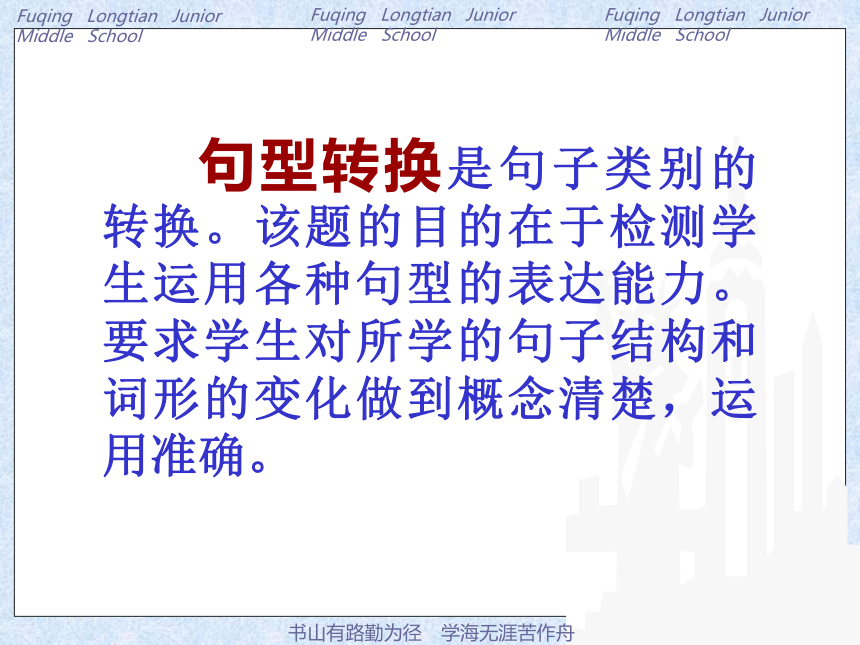


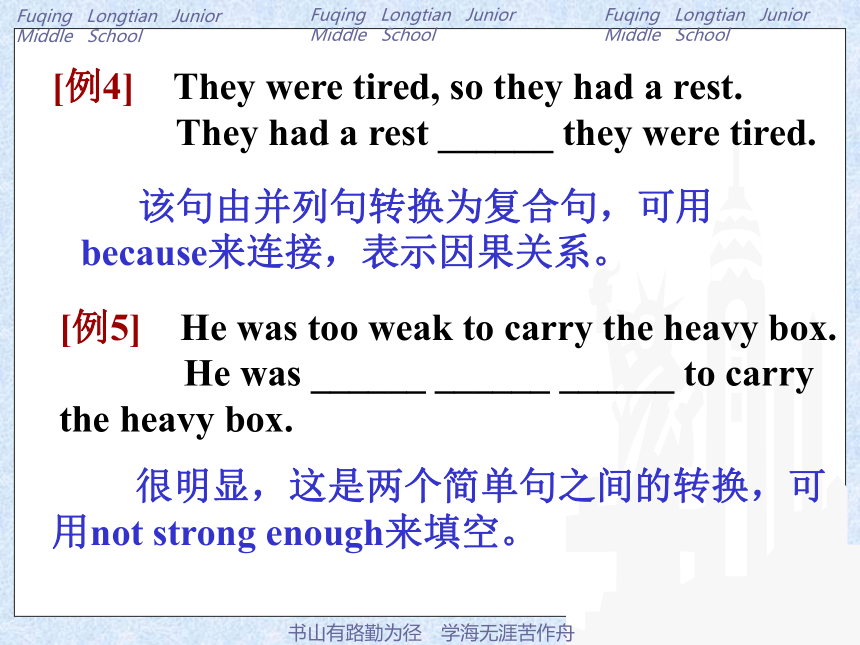
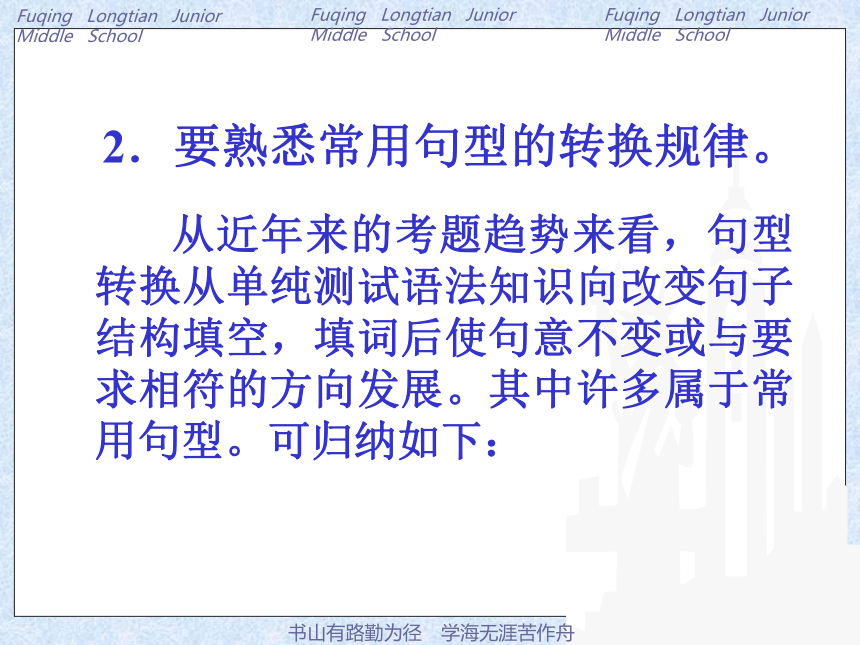
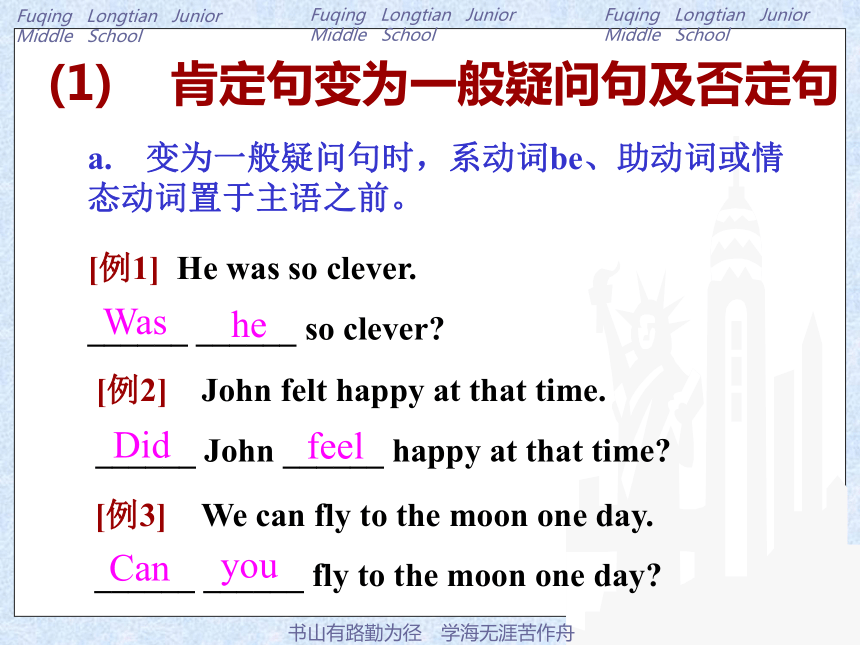
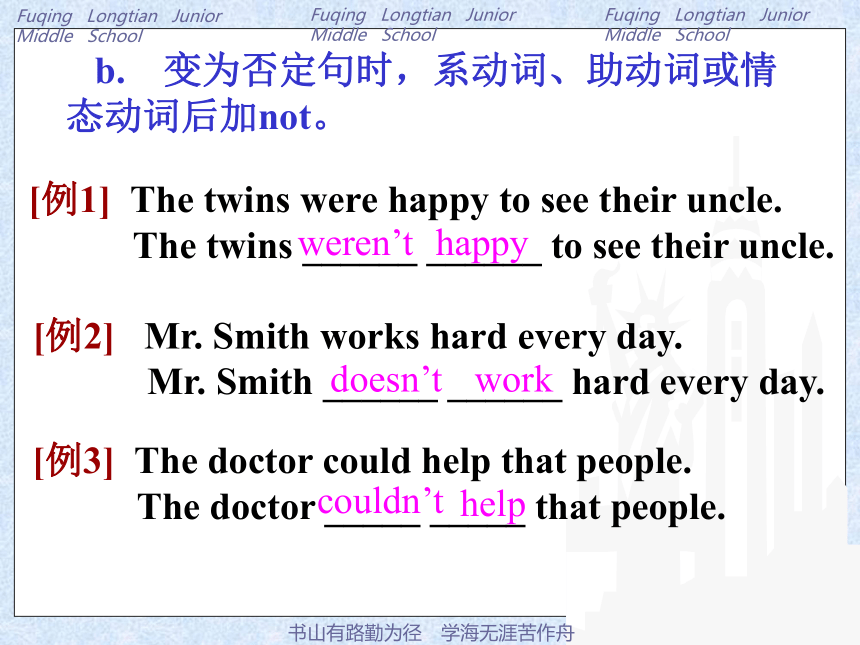
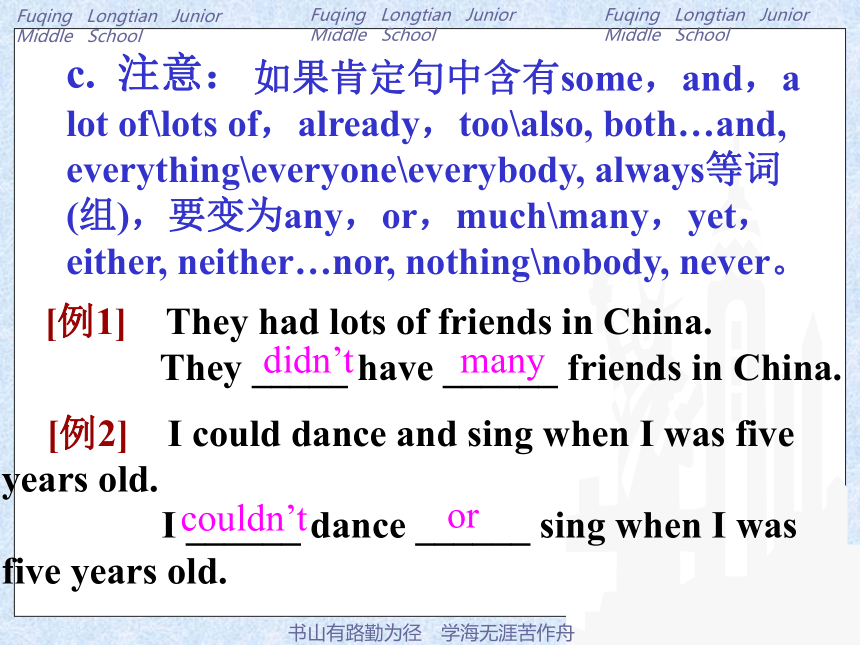
文档简介
课件24张PPT。句型转换制作 王家宏DE答题技巧江苏省高邮市川青小学 句型转换是句子类别的转换。该题的目的在于检测学生运用各种句型的表达能力。要求学生对所学的句子结构和词形的变化做到概念清楚,运用准确。
[例1] The little girl was so tired that she couldn’t go farther.
The little girl was ______ tired ______ go farther.
(一)?? 句型转换的解题应试技巧1.必须弄清原句的句型和意思以及判别改写后的句子是什么句型。 通过分析,我们不难发现,该题是由复合句转换为简单句,可用too…to句型。
根据我们所学过的同义词组,look after sb well相当于take good care of sb. [例2] It took him two hours to do these exercises yesterday.
He ______ two hours ______ these exercises yesterday.
该句的句型是It takes sb sometime to do sth. 英语表达该意思的还有spend…on句型。[例3] I must look after my sister well at home.
I must ______ ______ ______ ______ my sister at home.
很明显,这是两个简单句之间的转换,可用not strong enough来填空。 [例4] They were tired, so they had a rest.
They had a rest ______ they were tired.
该句由并列句转换为复合句,可用because来连接,表示因果关系。[例5] He was too weak to carry the heavy box.
He was ______ ______ ______ to carry the heavy box.
从近年来的考题趋势来看,句型转换从单纯测试语法知识向改变句子结构填空,填词后使句意不变或与要求相符的方向发展。其中许多属于常用句型。可归纳如下:
2.要熟悉常用句型的转换规律。
[例3] We can fly to the moon one day.
______ ______ fly to the moon one day?(1)??? 肯定句变为一般疑问句及否定句
a.????变为一般疑问句时,系动词be、助动词或情态动词置于主语之前。[例1] He was so clever.
______ ______ so clever?
[例2] John felt happy at that time.
______ John ______ happy at that time?WasheDidfeelCanyou
[例3] The doctor could help that people.
The doctor _____ _____ that people. ???b.??? 变为否定句时,系动词、助动词或情态动词后加not。 [例1] The twins were happy to see their uncle.
The twins ______ ______ to see their uncle. [例2] Mr. Smith works hard every day.
Mr. Smith ______ ______ hard every day.weren’thappydoesn’tworkcouldn’thelp
[例2] I could dance and sing when I was five years old.
I ______ dance ______ sing when I was five years old. 如果肯定句中含有some,and,a lot oflots of,already,tooalso, both…and, everythingeveryoneeverybody, always等词(组),要变为any,or,muchmany,yet, either, neither…nor, nothingnobody, never。c. 注意:[例1] They had lots of friends in China.
They _____ have ______ friends in China.
didn’tmanycouldn’tor
[例] He can make a model plane, I think. (否定句)
I ______ think he ______ make a model plane.[例1] Mother told me to go to bed early last night.
Mother told me ______ ______ go to bed early last night.
d. 否定前移e.? 一些特殊结构,变否定句时,在动词(词组)后直接加not。
don’tcannotto 另外,还有ask sb (not) to do sth,Will you please (not) do sth,had better (not) do sth,try (not) to do sth, decide (not) to do sth等。 [例2] Let’s play basketball on the playground this afternoon.
Let’s ______ ______ basketball on the playground.
notplay
[例2] The man in the car is my father’s friend.
______ ______ is ______ father’s friend? (2)??? 对划线部分提问 对划线部分提问是根据划线的内容提出一个特殊疑问句。即特殊疑问词+一般疑问句构成。a.?? 如划线部分是定语,它所修饰的词要跟随特殊疑问词移至句前。[例1] This is Kate’s hat.
______ ______ is this?
WhosehatWhichmanyour
[例2] Ann flew to Beijing last year.
What _____ Ann ______ last year? b.???划线部分如是谓语动词,应该用do的形式来取代。[例1] They are looking for the boy in the city.
______ are they ______ in the city?Whatdoingdiddo c. 常见疑问词(组):what,what+名词(如what colour,what grade等),when,why,where,who(whom),which,whose,how,how+形容词副词(如how long,how far,how often,how soon等)。要注意以上各种疑问词(组)的用法。 dd.?注意一些特殊词,如little,few,no,nothing,never等出现时,前半句表示否定的概念,后半句应用肯定形式。(3)??? 改为反意疑问句
反意疑问句的前半句为陈述句,后半句为简短的一般疑问句,在改写当中,要注意:a.???前肯后否,前否后肯;b.???人称、时态和数要保持一致;
c.???各种祈使句,反意疑问句的后半句都用will you,但Let’s…句用shall we;
[例4] Don’t tell him the bad news, ______ ______? [例1] Class 3 were the winners in the race, ______ ______?
[例2] The man couldn’t climb up the tree, ______ ______?
[例3] There is little water in the bottle, ______ ______?
weren’ttheycouldheistherewillyou 另外,注意以下句子:
I am a student,______ ______?
What a kind girl, ______ ______?
How fast the boy runs, ______ ______? aren’tIisn’tshedoesn’t he
[例3] I don’t know what I can do.
I don’t know ______ ______ do. (4)??? 复合句变为简单句 由复合句变为简单句时,一般都是将复合句中的从句改为不定式形式,或是介词短语的形式。比如so…that可以改写成too…to结构的简单句,但应注意to后面必须直接跟行为动词的原形。[例1] He was so young that he can’t read.
He was ______ ______ ______ read.
[例2] We can’t live if there is no air or water.
We can’t live ______ air or water.
tooyoungtowithoutwhatto
[例2] Li Lei is the tallest in his class.
Li Lei is ______ than ______ ______ student in his class. (5)???特定词组、句型的特殊用法
[例1] What’s the matter, Granny?
______ ______ with you, Granny?What’swrongtalleranyother
[例3] You can’t take both the basketball and the football.
You can take ______ the basketball ______ the football. (6)??? 同义句转换[例1] Li Ping does well in English.
Li Ping _____ _____ _____ English.
[例2] I can mend the bike. Li Lei can, too.
I can mend the bike, and _____ _____
Li Lei.
isgoodatsocaneitheror
[例2] His brother won’t do the shopping tomorrow. (改为一般现在时)
His brother _____ _____ the shopping on Sundays. (7)??? 时态转换[例1] We are going to help the farmers on the farm tomorrow. (用now改写)
We ______ ______ the farmers on the farm ______.
arehelpingnowdoesn’tdo
[例3] The flowers are beautiful.
______ ______ ______ they are!
______ ______ ______ flowers are! (8)改为感叹句[例1] The twins study Chinese very hard.
_____ _____ the twins study Chinese![例2] The weather was rather bad yesterday.
______ ______ ______ it was yesterday!
HowhardWhatbadweatherWhatbeautifulflowersHowbeautifulthe
3.反复推敲,确保无误。改变后要看看意思是否与要求相符,有没有语法和习惯用法方面的错误。(二)做句型转换时应注意的几个问题 首先应看清题意,分析句子结构,再按句子要求变换句型。1.注意时态;2.句子的成分不变。原句的句子在改变句型时仍不可缺少,否则句子不完整,但有一个例外,在陈述句改为感叹句时,要增加句子成分,感叹词what和how分别为按句子的要求而增加的定语或状语,句子其他成分不变;练习题(略)江苏省高邮市川青小学Thank you for your coming!Goodbye!2002.10.12江苏省高邮市川青小学
[例1] The little girl was so tired that she couldn’t go farther.
The little girl was ______ tired ______ go farther.
(一)?? 句型转换的解题应试技巧1.必须弄清原句的句型和意思以及判别改写后的句子是什么句型。 通过分析,我们不难发现,该题是由复合句转换为简单句,可用too…to句型。
根据我们所学过的同义词组,look after sb well相当于take good care of sb. [例2] It took him two hours to do these exercises yesterday.
He ______ two hours ______ these exercises yesterday.
该句的句型是It takes sb sometime to do sth. 英语表达该意思的还有spend…on句型。[例3] I must look after my sister well at home.
I must ______ ______ ______ ______ my sister at home.
很明显,这是两个简单句之间的转换,可用not strong enough来填空。 [例4] They were tired, so they had a rest.
They had a rest ______ they were tired.
该句由并列句转换为复合句,可用because来连接,表示因果关系。[例5] He was too weak to carry the heavy box.
He was ______ ______ ______ to carry the heavy box.
从近年来的考题趋势来看,句型转换从单纯测试语法知识向改变句子结构填空,填词后使句意不变或与要求相符的方向发展。其中许多属于常用句型。可归纳如下:
2.要熟悉常用句型的转换规律。
[例3] We can fly to the moon one day.
______ ______ fly to the moon one day?(1)??? 肯定句变为一般疑问句及否定句
a.????变为一般疑问句时,系动词be、助动词或情态动词置于主语之前。[例1] He was so clever.
______ ______ so clever?
[例2] John felt happy at that time.
______ John ______ happy at that time?WasheDidfeelCanyou
[例3] The doctor could help that people.
The doctor _____ _____ that people. ???b.??? 变为否定句时,系动词、助动词或情态动词后加not。 [例1] The twins were happy to see their uncle.
The twins ______ ______ to see their uncle. [例2] Mr. Smith works hard every day.
Mr. Smith ______ ______ hard every day.weren’thappydoesn’tworkcouldn’thelp
[例2] I could dance and sing when I was five years old.
I ______ dance ______ sing when I was five years old. 如果肯定句中含有some,and,a lot oflots of,already,tooalso, both…and, everythingeveryoneeverybody, always等词(组),要变为any,or,muchmany,yet, either, neither…nor, nothingnobody, never。c. 注意:[例1] They had lots of friends in China.
They _____ have ______ friends in China.
didn’tmanycouldn’tor
[例] He can make a model plane, I think. (否定句)
I ______ think he ______ make a model plane.[例1] Mother told me to go to bed early last night.
Mother told me ______ ______ go to bed early last night.
d. 否定前移e.? 一些特殊结构,变否定句时,在动词(词组)后直接加not。
don’tcannotto 另外,还有ask sb (not) to do sth,Will you please (not) do sth,had better (not) do sth,try (not) to do sth, decide (not) to do sth等。 [例2] Let’s play basketball on the playground this afternoon.
Let’s ______ ______ basketball on the playground.
notplay
[例2] The man in the car is my father’s friend.
______ ______ is ______ father’s friend? (2)??? 对划线部分提问 对划线部分提问是根据划线的内容提出一个特殊疑问句。即特殊疑问词+一般疑问句构成。a.?? 如划线部分是定语,它所修饰的词要跟随特殊疑问词移至句前。[例1] This is Kate’s hat.
______ ______ is this?
WhosehatWhichmanyour
[例2] Ann flew to Beijing last year.
What _____ Ann ______ last year? b.???划线部分如是谓语动词,应该用do的形式来取代。[例1] They are looking for the boy in the city.
______ are they ______ in the city?Whatdoingdiddo c. 常见疑问词(组):what,what+名词(如what colour,what grade等),when,why,where,who(whom),which,whose,how,how+形容词副词(如how long,how far,how often,how soon等)。要注意以上各种疑问词(组)的用法。 dd.?注意一些特殊词,如little,few,no,nothing,never等出现时,前半句表示否定的概念,后半句应用肯定形式。(3)??? 改为反意疑问句
反意疑问句的前半句为陈述句,后半句为简短的一般疑问句,在改写当中,要注意:a.???前肯后否,前否后肯;b.???人称、时态和数要保持一致;
c.???各种祈使句,反意疑问句的后半句都用will you,但Let’s…句用shall we;
[例4] Don’t tell him the bad news, ______ ______? [例1] Class 3 were the winners in the race, ______ ______?
[例2] The man couldn’t climb up the tree, ______ ______?
[例3] There is little water in the bottle, ______ ______?
weren’ttheycouldheistherewillyou 另外,注意以下句子:
I am a student,______ ______?
What a kind girl, ______ ______?
How fast the boy runs, ______ ______? aren’tIisn’tshedoesn’t he
[例3] I don’t know what I can do.
I don’t know ______ ______ do. (4)??? 复合句变为简单句 由复合句变为简单句时,一般都是将复合句中的从句改为不定式形式,或是介词短语的形式。比如so…that可以改写成too…to结构的简单句,但应注意to后面必须直接跟行为动词的原形。[例1] He was so young that he can’t read.
He was ______ ______ ______ read.
[例2] We can’t live if there is no air or water.
We can’t live ______ air or water.
tooyoungtowithoutwhatto
[例2] Li Lei is the tallest in his class.
Li Lei is ______ than ______ ______ student in his class. (5)???特定词组、句型的特殊用法
[例1] What’s the matter, Granny?
______ ______ with you, Granny?What’swrongtalleranyother
[例3] You can’t take both the basketball and the football.
You can take ______ the basketball ______ the football. (6)??? 同义句转换[例1] Li Ping does well in English.
Li Ping _____ _____ _____ English.
[例2] I can mend the bike. Li Lei can, too.
I can mend the bike, and _____ _____
Li Lei.
isgoodatsocaneitheror
[例2] His brother won’t do the shopping tomorrow. (改为一般现在时)
His brother _____ _____ the shopping on Sundays. (7)??? 时态转换[例1] We are going to help the farmers on the farm tomorrow. (用now改写)
We ______ ______ the farmers on the farm ______.
arehelpingnowdoesn’tdo
[例3] The flowers are beautiful.
______ ______ ______ they are!
______ ______ ______ flowers are! (8)改为感叹句[例1] The twins study Chinese very hard.
_____ _____ the twins study Chinese![例2] The weather was rather bad yesterday.
______ ______ ______ it was yesterday!
HowhardWhatbadweatherWhatbeautifulflowersHowbeautifulthe
3.反复推敲,确保无误。改变后要看看意思是否与要求相符,有没有语法和习惯用法方面的错误。(二)做句型转换时应注意的几个问题 首先应看清题意,分析句子结构,再按句子要求变换句型。1.注意时态;2.句子的成分不变。原句的句子在改变句型时仍不可缺少,否则句子不完整,但有一个例外,在陈述句改为感叹句时,要增加句子成分,感叹词what和how分别为按句子的要求而增加的定语或状语,句子其他成分不变;练习题(略)江苏省高邮市川青小学Thank you for your coming!Goodbye!2002.10.12江苏省高邮市川青小学
